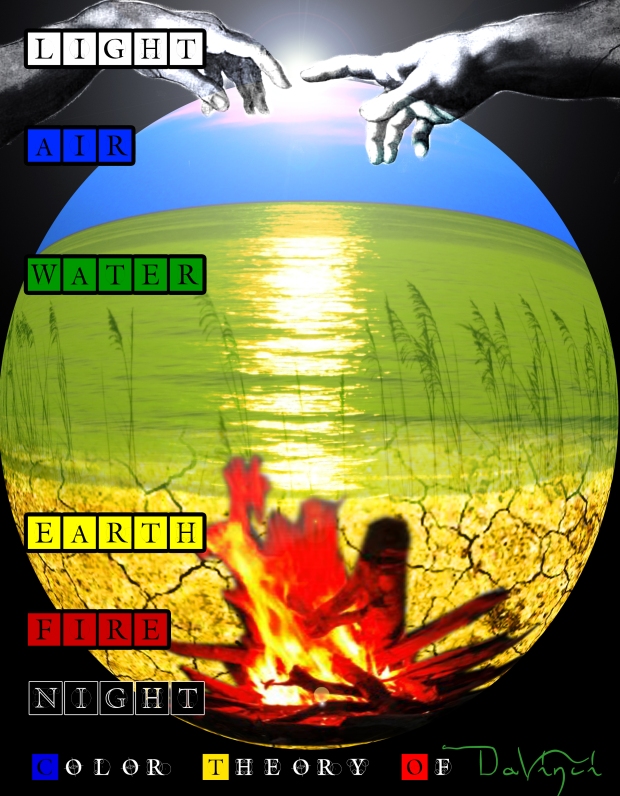
Da Vinci’s color theory.

Da Vinci’s color theory.
The study of color has been recorded at least since the time of Aristotle. Historical references such these give a sense of how we came to our current understanding of color. Here is a list and description of early color theorists.
Aristotle (384-322 B.C.E.) Most people remember Aristotle as the Greek philosopher and writer. Beyond this, he was an expert on various subjects including color theory. Aristotle was responsible for writing the first known book on color theory titled “DeColoribus”. His theory concluded that colors were derived from different mixtures of sunlight, fire, air, and water. To obtain black, one or more of these elements must be absent. Considering his theories, they are closely associated with the elements of earth:


Leonardo Da Vinci (1452 – 1519 C.E.) Da Vinci expanded on Aristotle’s theories and came up with an alternative hierarchy of color. In his work “Treatise on Painting”, he defined six basic hues of color associated with the elements. While Da Vinci maintained some relationships of Aristotle’s, such as blue-green for water, blue for air, and red for fire, he explored black and white as well; white was related to light in its purest form and black was related to the stark darkness of night.


Sir Isaac Newton (1642-1727 C.E.) Newton was the first documented “color theorist”. He brought a scientific method of investigation to the study of color. He sought to find a completely scientific explanation for the occurrence of color. Working with light prisms, he determined 7 color complements and created the color wheel. He wrote his book on color called “Opticks” and this was first published in 1692.

Jacques Christophe LeBlon (1667-1741 C.E.) LeBlon was a painter and engraver from Germany and he invent and adopt the four-color printing model RYBK which is still in use today. His original model RYBK, utilized Red, Yellow, Blue, and Black. LeBlon’s manuscript, Coloritto, describes his studies in color modes, primary versus secondary, and other color relationships.

Moses Harris (1730-1788 C.E.) Moses Harris was a scientist by trade as well as an engraving artist. His professional work in nature led to curiosity regarding how colors naturally exist in the world as well as how natural pigments influence the creation of pigments for paints. Harris studied Isaac Newton’s color theories and discovered that the combination of the three primary colors yields a dark hue, often referred to as black. His studies on color showed that combined pigments could create a dark hue rather than relying completely on naturally occurring dark pigments, which was the common standard previous to his discovery. Moses published his book The Natural System of Colours in 1766.

http://wordpress.com/post/64058623/new/
http://www.gutenberg-e.org/cgi-bin/dkv/gutenberg/slideshow_low.cgi?pn=28
Johann Wolfgang von Goethe (1749-1832 C.E.) Von Goethe is considered a pioneer in modern color theory. He had many talents including writing, poetry, art, and politics and would eventually turned his attention to color theory. He published Theory of Colours in the early 1800’s. He observed that the color we “see” is not just due to light passing through a prism or atmosphere but largely due to the interplay of light and dark such as along the edge of a crystal or prism. His declarations on color and perception opposed Sir Isaac Newton’s own views. Rather then focus on the science of color, Goethe focused on individual perception such as psychology and physiology of color. His perception based study of color is considered to be the first of its kind. His studies created the idea of complements/opposites in color theory.
